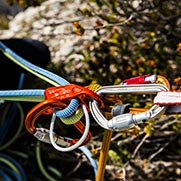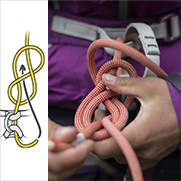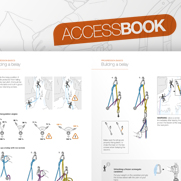RECOVERING ROPE OFFCUTS : RETHINKING WASTE MANAGEMENT
In 2024, we took a further step forward in our environmental approach by recycling more than 21 tonnes of rope offcuts from our production process. This project is all about rethinking waste management, and is led by a committed team. Manon de Gaulejac, Environment and Eco-Innovation Project Manager, Marlène Dechenaud, Responsible Purchasing Coordinator, and Tiphaine Gagneux, Eco-Design Manager, take a look back at the programme they built together.
May 21 2025
An innovative method to avoid incineration
The idea of recycling rope offcuts came about at a time when industrial waste management was becoming a key issue for companies committed to a CSR approach. “My main role at Petzl is to assess environmental impact, in particular via the carbon footprint (at group level) and life cycle analyses (at product level). Managing waste at our three French production sites is also part of the job,” explains Manon.
The rope offcuts recycling programme involves a partner in Italy, who sorts and recycles polyamide and polyester using a specific process. Our partner has the technology not only to identify the materials the ropes are composed of, but also to separate the core from the sheath when ropes are made of different materials: “the polyamide part goes back into the plastics industry to make recycled nylon, while the polyester is used in Italy to stuff cushions and sofas,” continues Manon. This approach avoids incineration and reduces the carbon footprint of production.
Rigorous sorting logistics
The issue of sorting quickly emerged as a major challenge. “We need to make sure that the right materials end up in the right bins. Not all offcuts can be incorporated into the recycling process, particularly 100% polyester rope, which is handled by our waste management provider in France,” says Manon.
Efficiency also depends on raising the awareness of in-house teams. “The production lines have had to adapt, adjusting from a single sorting bin to three. But we are seeing a gradual increase in skills, thanks to constant educational work and transparent communication with our service providers,” she adds.
Scaling the model
Petzl is aiming for an ambitious target of 80% material recovery from its waste by 2025, through recycling or reuse. Could the rope recycling initiative be extended to other types of waste? “First you need a minimum tonnage of one tonne per year for it to be viable, and then you need to be able to organise sorting effectively at source,” explains Marlène. A number of avenues are already being explored, particularly for the polyethylene foam used to transport helmet shells. “We throw away more than six tonnes of it every year, and we’re going to try halving this by restricting their use.” Another challenge is making the silicone-coated paper label substrates (glassines) recyclable, because they could be recovered and recycled locally. Manon insists that it’s important to have a pragmatic approach: “We can’t recycle everything. We need to strike the right balance between environmental impact, technical feasibility and economic constraints. ”
Going further
Petzl is also thinking about going one step further by recovering used ropes from its customers. “The idea would be to put in place a central collection scheme before sending them for recycling. But that means working through the strict regulatory framework on waste transport and management,” points out Tiphaine. For her part, Manon is already thinking about the next stage - the time when we will have eliminated rope offcuts at source, “by adapting the lengths of the ropes produced according to remaining stock.”
Related article: REUSE: THE WAY FORWARD FOR WASTE MANAGEMENT
Related News







